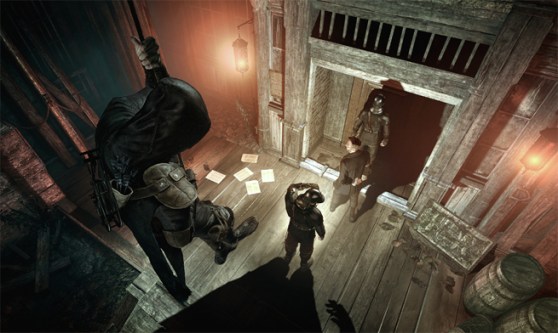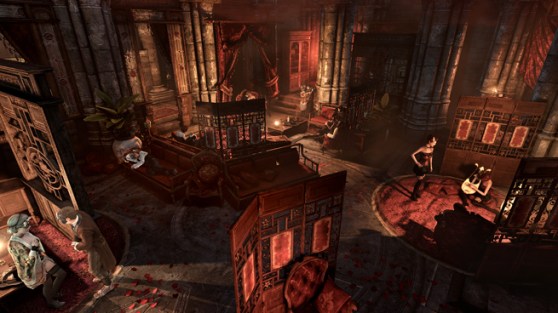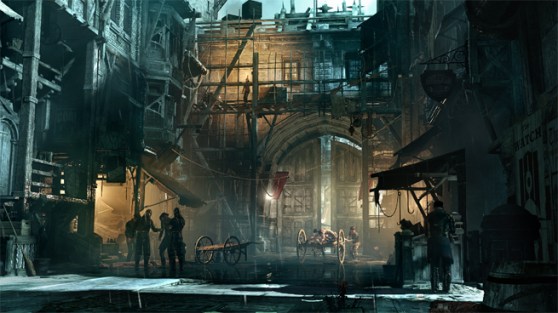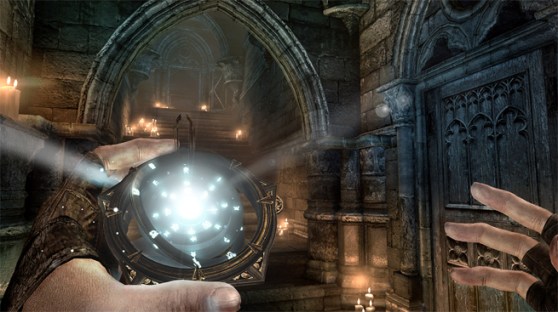It kicks normal pick-pocketing up a notch by letting Garrett snatch every last item of value off a victim without detection. In combat, it allows quick-time-event targeting of an enemy’s vulnerable spots, instantly dispatching the guard in your way. Focus is limited, and the thief who tries to Rambo through a job ends up dead fast. And often.
So while Corvo could take on groups of enemies with the right juggle of magic tricks and trip-mines, Garrett must be more selective about revealing himself. It’s still best to snuff lanterns with a dry-ice arrow (replacing water arrows), blackjack guards from behind, or pounce on them from a roof. Or avoid them altogether.
Stealing is quicker
But if Dishonored repeatedly paid homage to Thief, the motives behind Thief’s responses aren’t always clear. Garrett tracks Eastwick to the House of Blossoms, a high-end brothel that’s a dead ringer for Dishonored’s own house of ill repute, the Golden Cat. The resemblances are pretty staggering. Sure, Garrett will eavesdrop on prostitutes and clients, creep across rafters, and find secret areas, but even the general decor and color schemes seem weirdly similar.
The multi-path level design, however, shows more sophistication than Dishonored’s. Roy described the mission structure as infiltration, stealing, and escape, but the game flow in the demo went far beyond that. Just getting to the House of Blossoms involves a Mirror’s Edge-style parkour run to reach the gates before they close up tight. That smoothly folds into quietly removing guards, skulking around the brothel and prying out its secrets, spying on Eastwick, and nabbing the medallion, which has a few secrets of its own to uncover.
Each beat lasted just long enough, giving the player something new to do every few minutes. And just when Garrett finished unlocking the medallion to reveal a glowing energy inside it, Eastwick discovered the theft. Guards locked doors and started a room-by-room search, tightening the net around Garrett.
It felt nicely tense, but it’s tough to judge gameplay at this point. Operating on “god mode” with enemy A.I. switched to the “deaf and blind” setting, the demo’s version of stealth looked fairly broken. Garrett routinely moved past characters in plain view with nobody raising a voice in protest. A little balancing, a few tweaked settings, and it’s fixed. But as presented, it seems as if you could simply walk up to any of the distracted, disinterested non-player characters and politely request their valuables.
Even so, running on a tricked-out PC, Thief presents a compelling, gritty world filled with amazing complexity and beauty. Fire effects need some work, but a simple moment watching rain drip between the separating planks of a shoddy wooden balcony stood out as a demonstration of what’s now possible in a video game. Both Square Enix and Edios remain cagey about what platforms Thief will land on, but the technology fueling their game makes it seem unlikely, if not impossible, that any current-gen hardware could handle it.
It also raises a very serious bar for Dishonored 2. The master has returned, and once its stealth mechanics fall into place, Thief might just have a few more things to teach the student. And us.
VentureBeat's mission is to be a digital town square for technical decision-makers to gain knowledge about transformative enterprise technology and transact. Learn More




